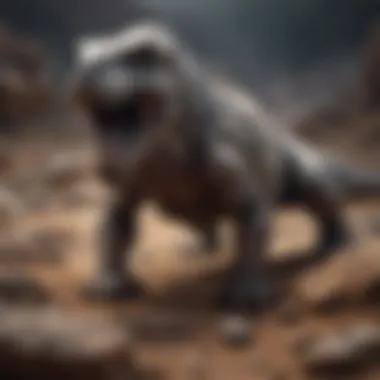The Significance of Rare Fossils in Earth's History


Intro
Rare fossils hold immense significance in the realm of paleontology, drastically enhancing our comprehension of Earth's history. These unique remnants not only represent biological organisms that lived millions of years ago but also serve as crucial indicators of past environmental conditions and evolutionary trajectories. Understanding their formation, the circumstances around their discovery, and the information they yield is vital for scholars and enthusiasts interested in Earth's geological narrative.
The study of rare fossils provides insights into ecosystems long extinct. With fossil records revealing a timeline of biodiversity, researchers can analyze patterns of extinction and migration, feeding into broader discussions about climate change and environmental shifts. This allows for a deeper grasp of how life has evolved and adapted through various geological epochs, thereby enriching our understanding of current biodiversity.
In this article, we will explore the formation processes of rare fossils, examine notable discoveries, and discuss the modern techniques used in paleontological research. Each section aims to furnish a comprehensive overview geared toward students, researchers, and professionals eager to delve into this critical area of study.
Prolusion to Rare Fossils
Rare fossils are crucial for understanding Earth's complex history. Their study sheds light on the diverse life forms that once thrived on our planet and the environments they inhabited. These fossils are not just remnants of past organisms; they are vital records that reveal significant biological and geological events.
The importance of rare fossils extends beyond mere curiosity. They provide key insights into ancient ecosystems and help scientists trace evolutionary processes. This can include significant biological transitions, extinction events, and adaptations. Moreover, rare fossils can challenge existing theories and fuel new research directions, making them indispensable in paleontological studies.
Definition and Characteristics
Rare fossils are defined by their scarcity and unique features. Unlike common fossils, which can be found in abundance, rare fossils often represent unusual organisms, specific geological time periods, or exceptional preservation conditions. Their rarity can be attributed to various factors, such as the environment in which the organism lived or the specific conditions required for fossilization.
The characteristics of rare fossils can vary significantly. For instance, some may exhibit remarkable detail in their structure, providing crucial information about the organism's life and environment. Others may come from organisms that had a limited geographical range, making their discovery even more valuable for understanding past biodiversity.
Importance in Paleontology
In paleontology, rare fossils hold exceptional significance. They can illuminate aspects of ancient life that are otherwise unknown. For example, the discovery of a rare fossil can lead to new insights into the behavior, diet, and ecology of extinct species.
Research on rare fossils also aids in the reconstruction of ancient climates and environments. By studying these fossils, scientists can draw parallels to modern ecosystems and understand how life on Earth has evolved. Additionally, rare fossils often prompt discussions around evolutionary relationships, helping to fill gaps in the fossil record.
"Rare fossils provide a window into Earth’s history, offering invaluable insights into the interplay of life and environment across millions of years."
Fossilization Processes
Fossilization processes are crucial for understanding how rare fossils form and what they reveal about Earth's history. These processes determine not only the conditions under which organisms are preserved, but also influence the quality and type of information that paleontologists can glean from these ancient remains. Additionally, knowing how different fossils form allows scientists to better interpret the data provided by these specimens.
Conditions Favoring Fossilization
Certain environmental conditions greatly enhance the chances of fossilization.
- Rapid Burial: Rapid entombment in sediments shields remains from decomposition and scavenging. Layers of silt or mud can quickly cover an organism, preserving it from the effects of the elements.
- Anoxic Environments: Low-oxygen conditions slow down the decay process. For example, underwater settings can be beneficial as they often limit bacteria and scavengers that contribute to decomposition.
- Mineral-Rich Waters: Bodies of water rich in minerals can facilitate the replacement of organic material with minerals, a critical step in processes like permineralization.
Types of Fossilization Methods
Several methods of fossilization exist, each contributing uniquely to our understanding of various life forms throughout geological history.
Permineralization
Permineralization occurs when mineral-rich water permeates organic tissues. As the water evaporates, minerals crystallize within the remains, preserving details of the organism's structure. One key characteristic is that it often retains microscopic features. Its utility in the article stems from its effectiveness in preserving soft tissues alongside hard parts, providing an insight into organism biology that may otherwise be lost.
However, permineralization's major limitation is its dependence on specific environmental conditions, making such fossils less common in certain areas. This method plays a pivotal role for paleontologists needing detailed anatomical information from ancient species.
Cast and Mold Fossils
Cast and mold fossils form when an organism leaves an impression in sediment, which can harden into rock. The molds often display external features, while casts can fill these impressions, replicating the object's shape. Its distinctive feature lies in how it captures the outline of the organism, providing crucial information about its morphology and size.
These fossils are important in contexts where traditional preservation fails. However, they may lack fine detail that other methods like permineralization provide. Despite this limitation, cast and mold fossils are invaluable for understanding the diversity and morphology of extinct life forms.


Amber Preservation
Amber preservation occurs when organisms become trapped in tree resin that hardens over time. This method is notable for preserving not only hard parts but also soft tissues and even DNA. The key characteristic of amber is its ability to encase organisms in exquisite detail, providing a snapshot of ancient ecosystems.
This type of fossilization is beneficial because it can protect specimens from decay for millions of years. However, this method is limited to specific types of organisms that have encountered resin, such as insects. Given its unique capacity to preserve delicate structures, amber holds significant scientific value in understanding biological interactions in prehistoric environments.
"The study of fossilization processes reveals much about the conditions that allowed for the preservation of life. Understanding these conditions can help connect the dots in Earth's extensive history."
Overall, the fossilization processes highlight how varied and intricate the preservation of ancient life can be, contributing extensively to our understanding of evolutionary biology and environmental changes through time.
Notable Discoveries of Rare Fossils
The study of rare fossils plays a vital role in the understanding of Earth's historical biological diversity and evolutionary processes. Each notable discovery contributes unique insights into extinct species and their environments, thus illuminating how life has changed over millions of years. This section explores specific fossil sites and key specimens that stand out due to their exceptional preservation and unique characteristics.
Exceptional Fossil Sites
Jehol Biota
The Jehol Biota is an extraordinary fossil site located in China, particularly known for its rich deposits that date back to the Early Cretaceous period. This site reveals a variety of well-preserved fossils, including plants, insects, and vertebrates. The key characteristic of Jehol is the exceptional quality of preservation found here, often including soft tissues and feathers that are rarely seen in the fossil record. This feature makes Jehol a beneficial choice for this article, as it showcases rapid burial conditions that led to remarkable fossilization. However, the downside is that many of the fossils are under threat from mining activities, raising concerns about their long-term preservation and study.
Burgess Shale
The Burgess Shale, located in the Canadian Rockies, is another popular fossil site famous for its preservation of soft-bodied organisms from the Cambrian period. Its significance lies in the wealth of diversity it reveals about early life forms, providing a window into the evolution of complex life. The key aspect of the Burgess Shale is its exceptional fossil quality, which includes complete specimens of organisms that showcased unprecedented anatomical features. This makes it an invaluable resource for researchers studying the early stages of animal life on Earth. Nonetheless, access can be challenging due to its remote location, which may limit the number of paleontologists who can study the fossils firsthand.
Solnhofen Limestone
The Solnhofen Limestone in Germany is renowned for its rich Jurassic fossil beds. It is here that the famous Archaeopteryx was discovered. The Solnhofen site is characterized by its delicate and exquisitely preserved fossils, often including feathers and fine details of skeletal structures. This unique feature on preservation not only provides insights into the evolution of birds but also offers a broader understanding of the ecosystems of the time. One disadvantage is that the sedimentary environment of Solnhofen can be fragile; therefore, care must be taken in excavation to avoid damaging these precious fossils.
Key Fossil Specimens
Archaeopteryx
The Archaeopteryx is a critically important fossil in the study of evolution. This specimen represents a transitional form between dinosaurs and modern birds, showcasing characteristics of both groups. The key aspect of Archaeopteryx is its well-preserved feathers, which provide substantial evidence for the evolution of flight. Its significance in this article stems from its ability to bridge the gap in understanding the origin of birds. One downside is that the rarity of such well-preserved specimens makes this understanding limited to a few finds.
Hallucigenia
Hallucigenia is another fascinating fossil from the Burgess Shale that contributes significantly to paleontological studies. Initially misclassified due to its unique morphology, Hallucigenia is now recognized as an early relative of a wide range of modern animals. The key characteristic of this specimen is its bizarre appearance, with spines along its back and tentacle-like appendages, which challenges traditional views of early animal life. Its unique features can help us understand evolutionary adaptations, but the unclear classification also presents challenges for scientists attempting to place it within an evolutionary context.
Anomalocaris
Anomalocaris is a notable predator from the Cambrian period, often regarded as one of the top predators of its time. Its key aspect is its unusual morphology, featuring large eyes and grasping appendages that set it apart from other marine life of the period. This specimen enhances our knowledge of Cambrian ecosystems and the evolutionary developments during that era. However, the discovery of Anomalocaris has led to some confusion regarding its classification, as it has been linked to different groups over time, showcasing the complexities of paleontological studies.
Notable fossil discoveries not only inform us about past life but also challenge our current understanding of evolution and biodiversity.
The Role of Rare Fossils in Evolutionary Studies
Rare fossils serve as critical pieces for reconstructing the complex puzzle of evolution. Their significance lies in their ability to provide insights into evolutionary transitions and adaptive radiations that have shaped life on Earth. These fossils often preserve unique morphological traits that illustrate the gradual changes occurring over geologic time. When studying these unique specimens, researchers can identify the evolutionary pathways that connect distant relatives, deepening our understanding of both lineage development and environmental adaptation.
Tracing Evolutionary Pathways
Tracing evolutionary pathways is vital for appreciating the gradual development of species and their adaptation to changing environments. Rare fossils can reveal previously unknown relationships between species, helping researchers fill gaps in the fossil record. For example, the discovery of transitional forms—like Archaeopteryx, a fossil that exhibits characteristics of both dinosaurs and modern birds—provides evidence of both avian and reptilian features. This showcases how significant changes can occur over time, endorsing the continuity of life through evolutionary mechanisms.
Additionally, these fossils can represent extinct groups, thus offering a mere glimpse of evolutionary history. By analyzing the morphology and stratigraphy of these rare finds, paleontologists track lineage divergence. The patterns observed in rare fossils help illustrate how environmental pressures, such as climate change and habitat loss, have influenced the rate of evolution. The more we learn from these fossils, the stronger our understanding of life's complex trajectory becomes.


Impact on Phylogenetics
Phylogenetics, the study of evolutionary relationships, heavily relies on both modern genetic tools and insights from paleontology. Rare fossils are fundamental in establishing phylogenetic trees, which visualize the evolutionary connections between species. Fossils like Hallucigenia, once puzzling, helped scientists redefine relationships within the Cambrian Explosion. With their unique anatomical features, rare fossils provide crucial data for molecular studies, complementing genetic analyses.
Moreover, the rarity often associated with these specimens can lead to special considerations in their study. Each find typically brings with it a wealth of information about extinct species, which molecular data alone might not encompass. By integrating fossil evidence into phylogenetic models, researchers improve the accuracy of evolutionary predictions. The combination of fossil morphology and modern genetics creates a more robust understanding of how species relate and evolve—highlighting links that are essential for comprehensive evolutionary studies.
"The rarest fossils often tell the most compelling stories about life's history."
In summary, rare fossils are indispensable in evolutionary studies. They provide tangible connections to past biodiversity, illustrate evolutionary transitions, and enhance our grasp of phylogenetic relationships. As research progresses, the importance of these fossils continues to be validated, confirming their critical role in understanding the intricate web of life on Earth.
Challenges in the Study of Rare Fossils
The study of rare fossils is not without its challenges. These challenges can significantly hinder our understanding of Earth's history. Addressing these issues is essential for paleontologists and researchers to make the most of these valuable specimens. Rare fossils unlock key insights into past environments, but if proper study methods are not employed, critical information may remain hidden.
Preservation Issues
The preservation of fossils is a fundamental factor affecting their study. Many rare specimens suffer from degradation due to environmental conditions, which can compromise their structural integrity and detail. Factors like acidity in soil, water saturation, and temperature fluctuations all contribute to this decay.
For instance, fossils that are found in sedimentary rock formations often have limited exposure to the elements. However, those exposed to erosion or human activity may not remain intact. This limits paleontologists' ability to analyze them comprehensively.
Consequently, understanding the specific conditions that lead to fossil preservation is crucial. Researchers often collaborate with geologists to assess sediment compositions and environmental factors that impact fossilization. Improved methods of preservation, such as using specialized resins or controlled environments for storage, can also play a vital role.
Accessibility and Ethical Considerations
Accessibility to rare fossils poses another challenge. Some fossils are locked away in remote locations or held in private collections, making them difficult to study. The scarcity of access not only limits scientific research but also hinders educational outreach. Rare fossils are often treasured objects within museums, attracting interest from the public, and their visibility outside of professional circles fuels curiosity and learning.
Moreover, ethical considerations surround the ownership and sharing of fossils. Cultural heritage issues arise, especially when fossils are discovered in regions where they hold significant historical context. For example, in certain countries, it is illegal to export fossils without government authorization. This raises questions about international scientific collaboration and repatriation of specimens.
Implications of Rare Fossils on Modern Science
Fossils are more than mere remnants of the past; they are essential to our understanding of biological and geological evolution. Rare fossils serve a unique role in this context. Their study offers critical insights into ancient ecosystems, evolutionary processes, and the events that shaped our planet. The implications of rare fossils extend deeply into modern science, influencing various fields such as biology, ecology, geology, and even climate science.
Understanding Past Biodiversity
Rare fossils provide a window into past biodiversity. They capture moments in time, documenting countless species that once thrived on Earth. By analyzing these specimens, scientists reconstruct ancient environments and ecosystems. This understanding helps us identify shifts in biodiversity through geological epochs.
Key discoveries such as the bones of the Woolly Mammoth or the preserved remains of ancient corals allow researchers to assess which species coexisted and how they adapted to changing climates. This data is vital for two main reasons:
- It allows us to compare past biodiversity with current ecosystems, highlighting changes and trends in species survival.
- It aids in the prediction of future biodiversity scenarios based on historical data.
Understanding how species responded to past climate changes equips ecologists with tools to forecast the impacts of ongoing global change. Such research emphasizes the fragile balance that sustains biodiversity.
Lessons for Future Extinctions
The extinction events documented through rare fossils offer valuable lessons on resilience and vulnerability. Specific patterns emerge when examining these extinction events, such as the end-Permian or the dinosaurs’ demise at the Cretaceous-Paleogene boundary.
A significant takeaway from this analysis is the relationship between environmental changes and species survival. By studying organisms that survived these turmoils, scientists can better comprehend the traits that contribute to resilience. Some important points to consider include:
- Species diversity: Ecosystems with a higher variety of species tend to recover faster after disturbances.
- Habitat flexibility: Species that adapt to a range of habitats show greater chances of survival in changing environments.
- Interaction networks: Understanding interactions among species helps predict how changes affect not just individual organisms but entire ecosystems.
"Learning from past extinctions allows us to make informed decisions about conservation strategies in the face of current extinction risks."
Thus, rare fossils are not merely time capsules; they are educational tools. They guide modern conservation efforts, illustrating what could happen if current trends in biodiversity loss continue. Applying insights garnered from fossil records can lead to more effective and proactive conservation strategies, ensuring a more sustainable future for Earth's diverse life forms.


Technology and Rare Fossil Research
Technology plays a crucial role in advancing our understanding of rare fossils. It has introduced tools and methodologies that allow researchers to explore fossils in unprecedented ways. Innovations in imaging and molecular analysis have opened new avenues in paleontological studies. These technologies not only enhance our capacity to study fossils but also help us gain insights into the past life forms and ecosystems.
Innovative techniques enable scientists to capture and analyze minute details of fossils, which are crucial for interpreting their significance in Earth's history. Advanced imaging techniques, for instance, allow for the visualization of structures that are not discernible to the naked eye. This has led to new discoveries and a deeper understanding of evolutionary processes.
Additionally, the recovery of ancient genetic material from fossils can provide insights into the biology of extinct species. This process can reveal relationships between ancient and modern organisms, helping to fill gaps in the fossil record. In this section, we will discuss these advanced techniques in detail.
Advanced Imaging Techniques
Advanced imaging techniques such as X-ray Computed Tomography (CT) and Synchrotron Radiation have transformed how paleontologists study fossils. These methods allow for non-destructive analysis, enabling scientists to explore internal structures without damaging the specimens.
- X-ray Computed Tomography: This technique produces three-dimensional images of fossils, allowing researchers to examine anatomical features that would otherwise remain hidden. The ability to visualize complex structures, like the intricate details of skull morphology in dinosaurs, provides new insights into their biology and behavior.
- Synchrotron Radiation: This method utilizes highly intense X-rays generated by particle accelerators. It offers high-resolution imaging and is effective in examining fragile fossils. For example, synchrotron imaging has been used to investigate the microstructure of fossilized dinosaur bones, revealing growth patterns that suggest insights into their life history.
These imaging methods are essential for researchers as they provide detailed context to rare specimens, revealing morphological traits that contribute to our understanding of evolutionary pathways.
DNA Recovery from Fossils
The recovery of DNA from fossils is another area that showcases the advancements in technology. This has made it possible to extract genetic material from specimens that are thousands or even millions of years old. The implications of this research are profound.
- Ancient DNA (aDNA) Analysis: Scientists use techniques including PCR (Polymerase Chain Reaction) to amplify traces of DNA found in fossils. This allows for the study of genetic material from organisms that lived long ago. By comparing aDNA with contemporary species, researchers can infer evolutionary relationships.
- Reconstructing Ecosystems: DNA analysis can help reconstruct ancient ecosystems. By identifying the genetic signatures of various species within a sediment core, paleobiologists can deduce past biodiversity and climate conditions.
However, the recovery processes come with challenges. The contamination of samples with modern DNA is a significant concern. Researchers must use rigorous protocols to ensure the purity of the ancient samples. Despite these difficulties, successful recoveries have provided key insights into extinct species, improving our understanding of their adaptations and environments.
In summary, technology is at the forefront of fossil research. Advanced imaging techniques and DNA recovery methodologies have significantly enhanced our knowledge of rare fossils. These technological advancements continue to shape the future directions of paleontological studies, allowing us to bridge gaps in our understanding of Earth's history.
Future Directions in Rare Fossil Research
The evolving landscape of rare fossil research is critical for advancing our understanding of Earth's history. As technology progresses, researchers devise methods to enhance fossil study. This section examines key areas where future research may lead, highlighting the importance of interdisciplinary approaches and public engagement.
Interdisciplinary Approaches
Interdisciplinary collaboration stands out as a vital component in rare fossil research. Scientists from diverse fields such as geology, biology, archaeology, and even computer science can contribute unique insights into fossil studies. Such collaboration can uncover new methodologies for fossil analysis, leading to more comprehensive interpretations.
For instance, integrating computational modeling and paleobiology might yield greater understanding of ancient ecosystems through simulations. Also, utilizing techniques from fields like chemistry allows for better analyses of fossil compositions, which can inform us about environmental conditions of the past. These interdisciplinary efforts can foster innovation, ultimately reshaping our perspectives on ancient life and extinction events.
Public Engagement and Education
Public engagement and education are also paramount for the future of fossil research. Raising awareness about the significance of rare fossils not only cultivates interest but can also garner support for paleontological endeavors. Educational programs aimed at schools and communities help disseminate knowledge about fossil significance and pathways of discovery.
Organizations can utilize social media platforms, such as Facebook and Reddit, to share findings and host discussions. This accessibility encourages a wider audience to partake in scientific conversations and promotes stewardship of fossil sites. Furthermore, public interest can lead to increased funding for research initiatives.
Engaging the public is as crucial as scientific discovery; both contribute to a richer understanding of natural history.
In summary, the future directions of rare fossil research intertwine technological advancements, interdisciplinary teamwork, and effective public outreach. These elements help illuminate the significance of fossils in Earth's narrative, ensuring a sustained interest in this field for generations to come.
The End
In synthesizing the information presented throughout this article, it is clear that rare fossils hold a pivotal place in the broader narrative of Earth's history. Their significance extends beyond mere biological curiosities; they serve as key indicators of past environmental conditions and evolutionary trajectories. As we delve deeper into the study of rare fossils, several specific elements emerge that underscore their importance.
First, these fossils offer crucial insights into extinct species and ecosystems, revealing not just what existed, but how life forms interacted with their environment. They bridge gaps in our understanding of biological processes and climatic changes over millions of years. This is evident in the study of key specimens, such as the Archaeopteryx, which illustrates the transition from dinosaurs to birds, spotlighting significant evolutionary shifts.
Furthermore, rare fossils contribute to our understanding of mass extinction events. They help scientists decipher patterns and causes, informing current debates about biodiversity loss and extinction risks today. For instance, analyzing fossils from the Burgess Shale can shed light on how ancient ecosystems responded to environmental stresses, providing lessons that are relevant in the context of today's climate crisis.
Another crucial consideration is the role of technological advancements in fossil research. Techniques like advanced imaging and DNA recovery from ancient remains enable researchers to extract more information than ever before. This capacity allows for a better grasp of genetic diversity and adaptation mechanisms within historical species.
"Rare fossils are not just remnants of the past; they are messengers that tell us about the evolutionary dramas of Earth's history."
Lastly, the continued study of rare fossils engages an interdisciplinary audience, merging geology, biology, and even ethics. Students, researchers, and educators find value in these studies, fostering a deeper appreciation for our planet's complex history. In a rapidly changing world, understanding the implications of these findings is not only academically enriching but also essential for informed discussions on conservation and sustainability.



